Exhibit 99.1
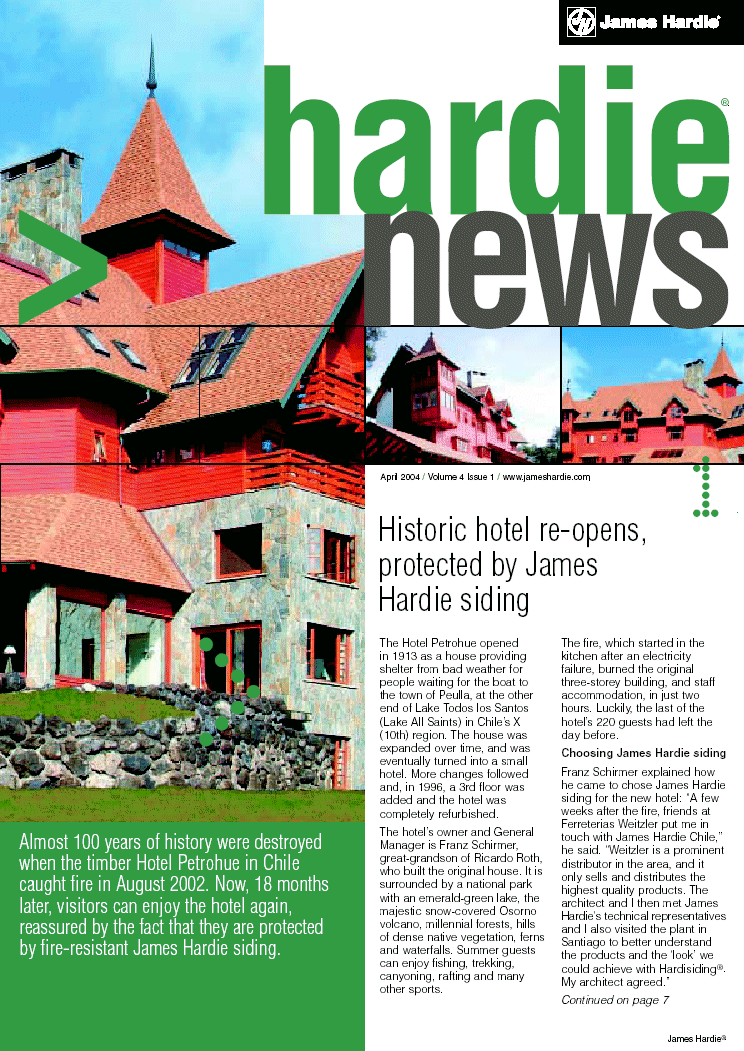
| April 2004 / Volume 4 Issue 1 / www.jameshardie.com
|
| Historic hotel re-opens,
protected by James
Hardie siding
|
| Almost 100 years of history were destroyed
when the timber Hotel Petrohue in Chile
caught fire in August 2002. Now, 18 months
later, visitors can enjoy the hotel again,
reassured by the fact that they are protected
by fire-resistant James Hardie siding. |
| The Hotel Petrohue opened
in 1913 as a house providing
shelter from bad weather for
people waiting for the boat to
the town of Peulla, at the other
end of Lake Todos los Santos
(Lake All Saints) in Chile’s X
(10th) region. The house was
expanded over time, and was
eventually turned into a small
hotel. More changes followed
and, in 1996, a 3rd floor was
added and the hotel was
completely refurbished. |
| The hotel’s owner and General
Manager is Franz Schirmer,
great-grandson of Ricardo Roth,
who built the original house. It is
surrounded by a national park
with an emerald-green lake, the
majestic snow-covered Osorno
volcano, millennial forests, hills
of dense native vegetation, ferns
and waterfalls. Summer guests
can enjoy fishing, trekking,
canyoning, rafting and many
other sports. |
| The fire, which started in the
kitchen after an electricity
failure, burned the original
three-storey building, and staff
accommodation, in just two
hours. Luckily, the last of the
hotel’s 220 guests had left the
day before. |
| Choosing James Hardie siding |
| Franz Schirmer explained how
he came to chose James Hardie
siding for the new hotel: “A few
weeks after the fire, friends at
Ferreterias Weitzler put me in
touch with James Hardie Chile,”
he said. “Weitzler is a prominent
distributor in the area, and it
only sells and distributes the
highest quality products. The
architect and I then met James
Hardie’s technical representatives
and I also visited the plant in
Santiago to better understand
the products and the ‘look’ we
could achieve with Hardisiding. |

James Hardie and the Foundation Inquiry

Peter Macdonald, CEO James Hardie
There has been
considerable media
attention focussed on
James Hardie
Industries NV since
the announcement of
the NSW Government’s
Special Commission of
Inquiry.
The sorts of comments
that are being
reported almost daily
in the Australian
media test the loyalty
of all us who work –
and care – for the
company. There are, of
course, many sides to
this story and we are
working to ensure the
media is informed
about our side of the
story.
Against this
background, we are
using these pages in
HardieNews to give you
the facts, so that you
can be confident that
the company behaved
honourably. The
creation of the
Foundation meant that
people who may be
injured by asbestos had
available significantly
increased money than
would otherwise have
been available.
Background to the inquiry
The NSW Government
established the
Special Commission of
Inquiry into the
Medical Research and
Compensation
Foundation in February
following an
announcement by the
Foundation last
October that it had an
estimated future
shortfall of $700
million to meet its
predicted future
claims.
Unions, plaintiff
lawyers and others
called on the
government to
investigate;
establishing this
inquiry allows the
government to seek more
information.
We welcome the inquiry,
and are co-operating
fully with it. We
regard it as an
opportunity for the
issues to be addressed
formally and in a
structured way, and
hope it will allow us
to deal
with some
misconceptions and
untruths which have
been put into the
public domain.
We believe that it will
provide an opportunity
for us to demonstrate
that what we have said
is correct, that the
company at the time did
the right thing, and
that we have no
obligation for any
potential future
shortfall that the
Foundation might
suffer.
The Terms of Reference
The Special Commission of Inquiry into the
Medical Research and Compensation Foundation
has the following terms of reference:
1. The current financial position of the
Medical Research and Compensation Foundation
(the MRCF) and whether it is likely to meet
its future asbestos related liabilities in
the medium to long term;
2. The circumstances in which the MRCF was
separated from the James Hardie Group and
whether this may have resulted in or
contributed to a possible insufficiency of
assets to meet its future asbestos related
liabilities;
3. The circumstances in which any corporate
reconstruction or asset transfers occurred
within or in relation to the James Hardie
Group, prior to the separation of the MRCF
from the James Hardie Group to the extent
that this may have affected the ability of
the MRCF to meet its current and future
liabilities; and
4. The adequacy of current arrangements
available to MRCF under the Corporations Act
to assist MRCF to manage its liabilities, and
whether reform is desirable to those
arrangements to assist MRCF to manage its
obligations to current and future claimants.
| |
|
|
1
> HardieNews
|
|
James Hardie® |
The establishment
of the Foundation
James Hardie Industries
Limited (or JHIL)
created the Foundation
in February 2001, to
undertake medical
research and look after
the companies that
compensate people who
may become injured by
asbestos products
produced by two former
James Hardie Group
companies.
The Foundation was
given all the shares
and the net assets of
the two former group
companies Amaba, and
Amaca. Amaba is the
company that formerly
produced brake
products, and Amaca is
the company that
formerly produced
building products. The
Foundation was also
given additional funds
for medical
research aimed at
finding treatments
and cures for
asbestos-related
diseases.
Since its creation, the
Foundation has been
completely independent
of James Hardie. It is
a non-profit
organisation, with its
own Board and
management who are
charged with being good
stewards of the funds
it holds, and using
these funds to properly
compensate legitimate
claimants against the
former group companies,
as well as continuing
to fund research into
asbestos disease.
The benefits of
establishing the
Foundation
The creation of the
Foundation provided
additional funding to
those former group
subsidiary companies
to meet claims that
may occur in the
future. It did not
remove potential
rights to claim
against any company
in the James Hardie
group.
The Foundation
provided future
claimants with much
greater certainty.
The Board at the
time believed that
the Foundation
should have
sufficient funds to
meet all anticipated
claims.
The establishment of
the Foundation was
fair, legitimate and
transparent. The Board
of the former parent
company, James Hardie
Industries Limited,
took into account
expert advice at the
time to determine the
funds that should be provided. As well
as the actuarial advice provided by
Trowbridge, other firms such as Access
Economics, PricewaterhouseCoopers and
Grant Samuel provided their expertise
to help the Board make its decision.
At the end of a lengthy
process, the directors
arrived at a balanced
solution they felt was
in the best interest of
the shareholders as
well as claimants.
The Foundation’s claims
The Foundation has
claimed that it may not
have enough assets to
meet all future claims
against it. It is
important to remember
that this isn’t a
discussion about
under-funding today.
The issue is about
using actuarial
projections to look
forward many years into
the future. To some
extent, therefore, this
is an argument about
actuarial estimates.
The inquiry is to
determine whether the
Foundation has the
funding required for
future claims.
No change to liability
The group’s legal
position was unchanged
by the creation of the
Foundation. The parent
company, James Hardie
Industries Limited,
had no liability for
the operating
activities of Amaca
and Amaba — including
the production of
asbestos-bearing
products — before or
after the creation of
the Foundation.
The Commissioner
The Special Commission of Inquiry is being headed by a former
Federal Court Judge, Mr David Jackson QC. Mr Jackson is an
expert in constitutional law and has extensive appeals experience.
Mr Jackson sat on the Federal Court from November 1985 to May
1987. Since then, he has conducted appeals and constitutional
cases in the High Court of Australia and in Intermediate federal and
state courts of appeal. His other areas of practice include advising
and acting as an Arbitrator and providing Expert Determinations.
Inquiry dates
We have been advised of the following dates for the inquiry:
| |
|
|
March 16
|
|
Preliminary hearing and
applications for leave to appear |
April 5-8
|
|
Public hearings |
April 14-16
|
|
Public hearings |
April 21-23
|
|
Public hearings |
April 27-29
|
|
Public hearings |
| |
May 3-7
|
|
Public hearings |
May 10-14
|
|
Public hearings |
May 24-27
|
|
Public hearings |
May 31
|
|
Public hearing |
| |
June 30
|
|
Commissioner due to report |
Public hearings take place at Level 8, John Maddison Tower,
88 Goulburn Street, Sydney.
| |
|
|
2
> HardieNews
|
|
James Hardie® |

James Hardie and the Foundation Inquiry
The former parent,
James Hardie Industries
Limited, was last
involved directly in
the production of
asbestos-bearing
products in 1937. In
that year, the assets
associated with
asbestos at that time,
were sold into James
Hardie & Coy, a new
independent company
with its own board of
directors and
management. From that
time on, the subsidiary
operated those assets
and built-up the
businesses until in
1998 it sold its assets
and ceased operating.
It retained the
proceeds of the sale of
its assets giving it
its highest ever net
worth. It had exited
from asbestos in 1987.
The brakes company
operated in a similar
way until its assets
were sold.
JHIL was a separate
holding company. It had
an independent board
and shareholders and
received
properly-authorised
dividends from its
subsidiaries. And it
has never — in any
jurisdiction, or in any
way — been found to
have been an operating
manager of James Hardie
& Coy.
That means liability
actually ceased in
1937, and the creation
of the Foundation did
nothing to change that.
The effects of re-structuring
The restructuring of
James Hardie, and the
creation of a Dutch
parent, James Hardie
Industries NV,
increased financial
efficiency and better
placed the company for
future growth. It did
nothing to change
claimants’ rights to
sue.
The restructure allowed
us to deal with global
international tax
issues and future
growth. As we were
growing and getting 80%
of our income out of
North America, we were
losing an increasing
proportion of our
pre-tax income to
taxing authorities,
such as the US
government, and
governments in Europe
and Asia. Our
shareholders, who are
predominately
Australian, would not
get the benefit of our
growth.
Indeed, at the time of
the re-organisation,
James Hardie
Industries NV agreed
to subject itself to
the jurisdiction of
New South Wales. This
is not the action of a
company that is
avoiding its
obligations.
The position for JHI NV
We believe that the
potential for
asbestos-related
claims arising from
the activities of
Amaca and Amaba to
have a material
adverse effect on JHI
NV remains remote. JHI
NV has never been
involved in any
asbestos claims, and
we don’t believe there
are grounds on which
JHI NV can be involved
in these matters.
The Foundation has
continued to
investigate its legal
options and its legal
firm, Clayton Utz, has
been in contact with
James Hardie. We have
seen legal analysis and
argument from the
Foundation but we have
seen nothing that in
any way alters our view
about the fact that JHI
NV
is not and will not
be liable for any
potential future
shortfall of the
Foundation.
The wider issue
Asbestos is an
important issue for the
whole community because
the use of asbestos in
Australia was very
widespread. It was used
in more than 3000
products, by hundreds
of companies, and
significant government
entities.
Amaba and Amaca are two
of around 150
defendants who are
brought into the legal
process by claimants
and they have been
found liable for around
15 per cent of claims
in the Australian
environment. However,
many of the other 150
companies and
government agencies
which produced,
distributed or used
asbestos building
products are no longer
around.
If an examination of
the Foundation’s data
and assumptions prove
that its estimate of
total costs is
realistic, then clearly
there have
been dramatic changes
over the past three
years, and other
defendants, including
state and federal
governments, must also
be affected by that
change.
It’s important to
remember that
governments imported
asbestos materials, and
specified their use
extensively in areas
outside those in which
James Hardie group
companies were
involved.
| |
|
|
3
> HardieNews
April 04
|
|
James Hardie® |
Keeping you informed
We want to ensure shareholders, employees and all other stakeholders
have information about the inquiry as soon as it becomes available, but
it is an unfortunate fact that the time taken to prepare and distribute
even a simple letter means that you will inevitably see reports from the
inquiry in the media before we can tell you about them.
Correcting inaccurate reports
Where we see inaccurate media reports, we immediately write to the editor
of the publication involved, and these letters typically appear one to two
days after the original story. The letters are also posted on the
Foundation Inquiry page of the James Hardie IR website at
www.jameshardie.com
Websites
We are posting as much information as we can to our IR website, as
quickly as possible. You can see these items by visiting the Investor
Relations area of www.jameshardie.com, and selecting the Foundation
Inquiry heading under What’s New on the IR home page.
The Commission has also set up a website, which can be opened at
www.lawlink.nsw.gov.au or by using the link on our Foundation Inquiry
page.
Register for email alerts
If you have access to email, you can register to receive an email
alert when we send out media releases or provide new presentations. To
register, use the News & Information Email Alert registration form on
the James Hardie IR website.
Email us
Questions or comments can be
emailed to us using one of the
following addresses:
[email protected]
[email protected]
[email protected]
Call us
Alternatively, you can phone:
Alan Kneeshaw on (02) 8274 5274
Shane Grimes on (02) 9274 5225
These include
shipping insulation,
industrial building
insulation and
industrial
insulation.
All the way through
the 2nd World War,
ships could only be
built with asbestos
insulation. James
Hardie companies had
nothing to do with
that. Companies were
importing bulk
asbestos and making
asbestos rope and
putting it on pipes
and putting plasters
on top. Many
industrial
contractors and other
companies were
involved with this,
but they just don’t
seem to get a mention
today.
If what the
Foundation says is
correct, I suspect
that considerable
responsibility
already lies with
the federal
government and all
the state
governments.
This is the group
that had the most
knowledge about
asbestos, the most
scientists studying
it, and that was
participating in
global conferences
about its health
effects. State and
federal governments
specified how the
products could be
used, and had
inspectors in all
James Hardie
factories and in the
workforce,
signing-off everyday
that it was being
used properly.
Tragically, everyone
was wrong.
Use of asbestos by former James Hardie subsidiaries
The use of blue (crocidolite) asbestos in James Hardie products
ceased in 1968 once the association between blue asbestos and
mesothelioma was firmly established.
The use of all other forms of asbestos was phased out — prior
to government bans — and complete exits were in place as
follows:
| - |
|
building products — 1983 |
| - |
|
friction products — 1986 |
Asbestos continued to be used by many others in Australia until
December 31, 2003, when the re-use, stockpiling and sale of asbestos
was finally banned.
It now appears there
wasn’t a safe level
of exposure. But
who’s responsible in
those circumstances,
where the material
used is not only
regulated, with the
regulations enforced
by various
governments around
the country, but in
fact its use was
specified by
governments?
If what the Foundation
is saying is true, and
given that the former
James Hardie companies
are liable for 15% of
claims, there is a
need to get on to the
table what happens to
the other 85% of
people who may become
injured.
I think this needs to
be dealt with
as a national issue.
But I will leave more
comment on this until
we see the outcome of
the current inquiry.
The James Hardie
success story
In all the discussions
that are taking place,
it is important not to
lose sight of the
tremendous success
story that is James
Hardie. The former
group subsidiaries
which used asbestos
were among the first
companies in the world
say “this is something
we don’t want to do
anymore” and to start a
research project to
find a replacement
product.
Well before any change
in the law, well
before it was required
for environmental
reasons, well before
substantial numbers of
claims began, the
former subsidiaries
voluntarily decided to
stop using this
material. At that
point, the government
still permitted, and
regulated, the use of
asbestos.
Now, in North America
we are the largest
producer of siding,
and we’re still only
about a third our
potential size. We’ve
also developed new
technologies and found
new areas where we can
use them — in pipes,
and in roofing. The
research that led to
this was carried out
quite recently here in
Australia, and it
still goes on here:
that’s a fantastic
success story.
| |
|
|
4
> HardieNews April 04
|
|
James Hardie® |
|
|
|

|
|
Renovation gives grand house a new future |
| |
|
|
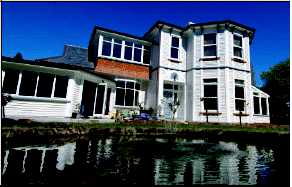

The pioneering spirit
that built this grand
farmhouse 140 years
ago has seen it
restored to its
former glory –
thanks to the vision
of the original
owner’s great
grandson, the passion
and inventiveness of
the architect and
builder, and 6kms of
James Hardie Linea®
weatherboards.
The decision to
re-clad, re-build and
re-detail this
fourth-generation
family home using
Linea® weatherboards
and trim saved it from
being demolished, and
preserved a fascinating
slice of New Zealand’s
pioneering history.
Grand piece of architecture
When Job Osbourne built
the house in Canterbury
in 1863, it was a grand
piece of architecture,
clad in Kauri
weatherboards and
extensively detailed
with chunky corbels,
thick Matai window
sills, decorative
shaped aprons under the
windows, fluted edges
on all the facings, and
a thick plinth around
the entire house at
first floor level.
“The detailing gave
the house its
character,” says the
current owner, Simon
Osbourne, “But it also
presented the biggest
challenge from a
maintenance point of
view. For example, the
plinth needed to be
painted in a dark
colour, but blistering
and cracking was a
real problem. Guided
by our architect,
Roger Buck, we knew if
we wanted a lower
maintenance house, we
were going to have to
reclad in Linea
weatherboards and put
as much of the
detailing as possible
in Linea trim as
well.”
Builder and local Linea
range expert, Arthur
Edwards, took on the
challenge: “We used the
Linea system’s weatherboards,
facings and box
corners, but when it
came to detailing like
the corbels, window
aprons and the sills we
had to be inventive,”
he said.
The big corbels were
constructed out of
seven thicknesses of
Linea trim and the
smaller ones out of
three thicknesses,
laminated together with
moisture-aired glue and
laser-cut. Window
frames were all
constructed from
laminated Linea trim
including new frames to
hold and preserve the
original lead-lighting
used around the front
entranceway.
“We recreated fluted
edge facings in the
Linea facings using a
jig and a belt sander
and replaced the
original Matai plinth
with an identical one
fashioned out of many
layers of Linea trim
and shaped with a belt
sander. The big
sloping Matai sills
have also been
re-fashioned out of
layers of laminated
Linea trim,” said
Arthur Edwards.
The home’s original
match-lined soffits
have been replaced
with Hardigroove™
Lining, another
low-maintenance James
Hardie product.
| |
|
|
5
> HardieNews April 04
|
|
James Hardie® |
|
|
|

|
|
Update for ArtistaTM Columns range |
| |
|
|
James Hardie has
updated its columns
range with the launch
of Artista™
Columns. The launch
has also provided us
with an opportunity
to remind the market
how much these
innovative, simple
linear forms can
enhance residential
and commercial
designs.
For improved handling
and safety, and to save
time on site, the
Artista Columns range
includes lightweight
Classic columns whose
overall weights have
been reduced by between
20%-30% over the
original range
(depending on diameter
and length).
For example, the 195mm
diameter Classic column
in the new range weighs
25.5kg for the 2.75m
length and 38kg for the
4m, a reduction of
approximately 20%. The
250mm diameter Classic
column is now 32kg for
the 2.75m length and
47.5kg for the 4m
length, approximately
33% lighter.
Builders, designers and
homeowners in Australia
can now choose from six
decorative capitals,
bases or rings to dress
their choice of Classic
or Tapered columns.
Artista Columns offer a
smooth finish that can
be easily painted,
rendered, applied with
stucco or tiled. All
offer load-bearing and
maintenance benefits
over other formed
column products.

|
|
|

|
|
Californian wildfires provide lessons in fire-resistance for homes |
| |
|
|
Wildfires destroyed
nearly 3,600 homes
in Southern
California counties
last November. Now,
investigations
have revealed some
valuable lessons in
home fire-resistance.
The historic Southern
California town of
Julian was one area
affected by the
state’s largest-ever
wildfires. The town
was evacuated on
November 4 and, while
the San Diego County
firefighters managed
to save the community
as a whole, some homes
were damaged by fire.
When he inspected
homes after the fires,
local builder, Randy
Flint, was impressed
with the performance
of fibre cement
exterior siding, which
he found to be highly
resistant to the
fires.
“One of my customer’s
homes was among the
few that survived the
fire and I was amazed
by the condition of
the fibre cement
siding that I
installed,” said Randy
Flint, builder for
Taskmaster Innovation
in Julian. “The vinyl
trim melted, half of
the windows buckled
and blew out and the
paint on the fascia
blistered, but the
siding remained in
perfect condition. The
siding was
instrumental in saving
the home.”
Julian Fire Chief,
Kevin Dugal strongly
recommends James
Hardie siding to
Julian area residents
who want the look of
wood. “Because I’ve
seen James Hardie
siding prevent homes
from burning, I
recommend it by
name,” he said. “It’s
been on the market
the longest and I
trust its
performance.”
James Hardie fibre
cement exterior
siding is renowned
for its performance
in fire and is
included on the
Colorado State Forest
Service’s list of
recommended building
products.
To aid in the
rebuilding of homes in
Southern California,
James Hardie pledged a
bulk donation of its
building products to
the California
Office of Emergency
Services.
| |
|
|
6
> HardieNews April 04
|
|
James Hardie® |
|
|
|

|
|
Historic hotel re-opens, protected by James Hardie siding |
| |
|
|

Cover story continued
The project features
extensive areas of 8mm
Hardisiding
weatherboards, fitted
over a cement
structure. To achieve
an authentic timber
appearance, the siding
was coloured using a
locally-made stain
called Algifol.
James Sicker, Manager
of James Hardie in
Chile, describes Lake
Petrohue as one of the
most beautiful places
in Chile. “When I heard
that the hotel had
burned down, I
immediately set out to
convince Franz and his
team to use our
product. I knew the new
hotel would be an ideal
place to show the full
design and
architectural potential
for our product as a
replacement for wood
and vinyl.
“We plan to use the
Hotel Petrohue as a
centerpiece of future
advertising and
promotional activities
in Chile, and will
hold a small training
event there with top
builders and
architects later in
the year.”
The new hotel was
designed by architect
Luis Quiroz and built
by Constructora Meza y
Cia Ltda.
It incorporates the
latest technology,
bigger rooms, top
quality building
products, and a
comfortable and
easy-to-operate design.
Franz Schirmer says it
is far better than the
old building, although
the architectural lines
were kept the same.
“Luis Quiroz knew the
story of the place and
was able to blend in
all the ingredients,
such as the building,
the natural
surroundings and
history,” said Franz.
“He was also able to
get the beautiful
outdoors into the
building, by means
of large windows and
glass roofs; it’s a
masterpiece.
“Now you can see the
end-result of our good
choice of materials: we
achieved low-cost
maintenance with the
look of wood and — very
importantly — it is
fire-proof!”
|
|
|

|
|
Improved fascia boards for Philippines |
| |
|
|
James Hardie
Philippines has
launched an improved
version of its
HardiSenepa®
fascia board.
Photographed at the
launch of the new
HardiSenepa board in
Batangas in the Luzon
Region were (L to R):
Ariel Avenido (Sales
Representative);
Rolly Tan
(Distributor);
Anthony Bondad (Sales
Representative); Aloy
Tadeo (Area Manager -
South Luzon); Dan
Casey (General
Manager — James
Hardie Asia and
Philippines); Lei
Punsalang (Assistant
Product Manager -
HardiSenepa); and
Jett Bije (National
Sales Manager)
Although fascias are
considered a “hidden”
part of construction,
they have a functional
and aesthetic purpose -
and both are better
served by the new
HardiSenepa® boards.
Functionally, fascia
boards provide a
foundation for the
gutter. In this role,
they need to be
impenetrable to prevent
vermin and the elements
from seeping into a
home through the eaves.
Aesthetically, fascias
draw attention to the
elaborate roof
designs that Filipino
homeowners prefer.
“Market research showed
us that homeowners
were looking for a
lighter, more
affordable and more
durable senepa for
their homes,”
explained Lei
Punsalang, Assistant
Product Manager for
HardiSenepa boards.
“That’s exactly what
the new HardiSenepa
boards offer.”
The new HardiSenepa board is shorter, and comes in two thicknesses, 9mm and
12mm. The new thicknesses contribute to the lighter weight, and make it easier
to install. The product
also has a smooth
surface so it is ready
for staining, or
painting with standard
latex paints.
The shorter lengths
also make it easier
for more hardware
stores to stock
HardiSenepa boards, so
it is easier for
customers to find it.
The range of
HardiSenepa boards is
promoted using the
slogan “Ang senepang
walang katabla vs
kahoy” which translates
as “no match or equal
in terms of durability
or affordability versus
ordinary wood”.
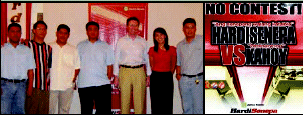
| |
|
|
7
> HardieNews April 04
|
|
James Hardie® |
|
|
|

|
|
Hardie starts winning over Europe |
| |
|
|
Pictured right is
Chezy, the first
French home for
which James Hardie
supplied
Hardiplank®
siding
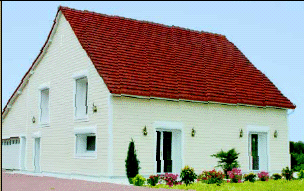
James Hardie is now selling products in France and the United
Kingdom following the establishment of James Hardie Europe,
based in Amsterdam in the Netherlands.
After starting sales in
early 2003, James
Hardie has been
actively selling
Hardibacker®
tilebacker and
Hardiplank® siding
products for most of
Financial Year 2004.
Products are shipped
from the USA and
finished at our
facility in Eastleigh
in Southern England.
Roy Koning, Marketing
Manager for James
Hardie Europe, reports
that – while the
business is still in
the early stages – it
is already winning-over
distributors,
architects, contractors
and builders.
“Highlights from the
first year of trading
in the UK include
signing a supply
contract with the
biggest Do-It-Yourself
tile distributor, Topps
Tiles, and signing an
exclusive deal with
Sheffield Insulations,
a large merchant,” he
said.
“We are also making
steady progress in
France, signing-up Le
Plateforme de Batiment,
part of the
international Saint
Gobain group, and
winning favour with
regional distributors
in both product
groups.”
Hardibacker tilebacker
was awarded “Most
Popular Product of
2003” in the
Professional Builder
Magazine in the UK and
we were present at the
UK tradeshow 100%
design in August 2003,
and the French
tradeshow Bâtimat in
Paris in November.
“Both shows generated
great interest in our
products, and
architects and
contractors who had
already worked with
James Hardie products
were very happy to see
us there,” said Roy.
“This year, we are
concentrating on
building the business
further in France and
the UK, specifically
strengthening and
developing our
distribution chain,
finalising product
technical approvals and
continuing to maintain
a strong presence
through trade
advertising and
tradeshows.
“As we learn more
about our markets
every day, we are
confident that the
European business
will go from strength
to strength.”

| |
|
|
8
> HardieNews April 04
|
|
James Hardie® |
|
|
|

|
|
Calendar ensures every day starts with Safety |
| |
|
|

(L to R): the
illustrations for
June and July were
drawn by Kara Brose
and Heng Feng Cai
respectively
James Hardie
employees and their
families in
Australia, New
Zealand and the
Philippines are
working their way
through a
safety-conscious
year, thanks to the
2004 Safety
Calendar.
The pre-cast
FlexiPit™ system
from James Hardie FRC
Pipes offers
designers and
installers a
better-performing,
more versatile,
pre-cast stormwater
pit system than has
been available
before.
Following an expansion
of the Australia and
New Zealand safety
program, a colourful
2004 Safety Calendar
was sent to every
employee’s home.
EH&S Co-ordinator, Alan
Bettison, said the 2004
Safety Calendar had its
roots in the expansion
of the business’s
safety program three
years ago. “We started
using the theme ‘Safety
is forever, not just
whenever’ to encourage
people to be as safe at
home with their
families as they are at
work. We wanted people
to perceive safety as a
way of life, not a 9-5
job,” he said.
To include families in
the safety message,
employees’ children
were invited to take
part in a safety poster
competition. “We have
run the competition for
three years now and
every year, very fine
work is created,” said
Alan Bettison. “This
year, we thought it
would be a great
idea to show James
Hardie families what
our children can do!”
Children were invited
to create posters
using one of three
themes:
| • |
|
Environment — our air, our land and our water |
| |
| • |
|
Healthy Living — good food, good habits, good fitness |
| |
| • |
|
Safety — at work, at home, at play |
Entries were invited in
three age groups:
under-8; 9-12 years;
and 13-16 years. The
2004 calendar features
the winners in each age
group from the
Australian and New
Zealand manufacturing
sites.
Everyone who
contributed an entry
won two movie
tickets, and there
were also prizes for
1st place ($250); 2nd
place ($100) and 3rd
place ($50).
|
|
|

|
|
New FlexiPit™ System |
| |
|
|
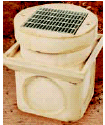
The system consists of
three main elements,
each of which can be
varied to suit
individual project
needs. They are:
| • |
|
a pit unit at the base |
| |
| • |
|
an FRC™ pipe riser to bring the unit to surface level, and |
| |
| • |
|
a pre-cast concrete top piece with a grate to suit traffic and surface conditions. |
The system has a
unique internal
circular design
which gives it
impressive hydraulic
performance and
significant
construction load
strength and ensures
that minimal debris
accumulates in pit
corners.
Installers of the
FlexiPit™ system
appreciate its ease of
installation in pit
placement, because the
vertical alignment of
pit body to pit top is
not critical. In
addition, using FRC™
pipe risers means that
risers can be
cut-to-length on site,
which improves the
accuracy of surface
level to invert.
| |
|
|
9
> HardieNews April 04
|
|
James Hardie® |
|
|
|

|
|
Modern materials give homeowners the best of old and new |
| |
|
|
Tagaytay Woodridge
Building 5 features
HardiPlank®
siding and
HardiSenepa®
sheets from James
Hardie
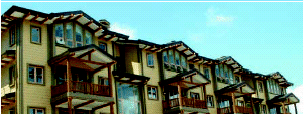
Developers are
using modern
building materials
such as
HardiPlank®
weatherboards to
capture traditional
architectural
styles for
newly-popular areas
such as the
Tagaytay Highlands
in the Philippines.
Demand for weekend
and vacation
accommodation in
cooler highland areas
is driving the
development of new
residential
communities in areas
such as Tagaytay, two
hours from Manila. A
good example of these
is Highland Prime
Inc’s The Woodridge
at Tagaytay
Highlands.
Perched on one of the
highest points of
Tagaytay, The
Woodridge is a
residential enclave of
138-mid-rise
condominium units of
two or three bedrooms.
The development’s
facade features the
extensive timber and
stone appearance that
is the hallmark of
local mountain
architecture.
Instead of using
natural wood for the
facades, however, The
Woodridge designer
searched for better
alternatives.
“Our client wanted the
wood siding look
without using wood,”
said architect Butch
Zamora of Makati-based
Recio+Casas Architects.
“Wood is now rather
scarce, and therefore
expensive. And there is
the problem of
movement. In our search
for alternative
materials, we ventured
from pre-cast concrete
to the exterior
insulation finish
system type of wall
system.”
The designers found
what they were looking
for in the
HardiPlank® siding
manufactured by James
Hardie. Unlike wood,
HardiPlank siding has
higher density, so it
is easier to paint, and
there is no movement,
ensuring the stability
of the design.
HardiPlank siding is
also more durable,
fire-resistant and
termite-proof. It has
the distinct advantages
of looking like timber
and having the strength
of fibre cement.
“And unlike wood, its
processing is not a
major consideration,”
said Butch Zamora. “We
simply had to source
the planks from James
Hardie in Cabuyao,
Laguna, so we could
build faster and be
more cost-effective.”
|
|
|

|
|
National award names James Hardie as Supplier of the Year — still! |
| |
|
|
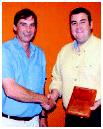
James hardie Building Products Australis has been awarded the prestigious “Supplier of the Year Award-2003”
form the Mitre 10 National Trade Division, for the third year in a row.
The award is voted for
by all members of
Mitre 10’s National
Trade Division on the
basis of which
supplier adds the most
value to their
business.
A Mitre 10 spokesman
described the three
awards in a row as “a
remarkable
achievement”. “The
award is determined
solely on the votes
cast by the member
stores of the National
Trade Division, and is
therefore a direct
reflection of their
assessment of your
organisation,” he said.
Congratulating
Australian employees
on the win, Rob
Verguizas, National
Account Manager,
thanked everyone for
“contributing to the
success of our
business and
ultimately the
experiences enjoyed by
our customers”.
Corrie Heslop,
National Business
Manager Timber and
Building Supplies for
Mitre 10 Australia
Limited (left)
presents the Supplier
of the Year Award 2003
to Rob Verguizas,
National Account
Manager, James Hardie
Building Products
| |
|
|
10
> HardieNews April 04
|
|
James Hardie® |
|
|
|

|
|
Harditrim® XLD™ planks win HOME Magazine 2004 American Building Product Award |
| |
|
|
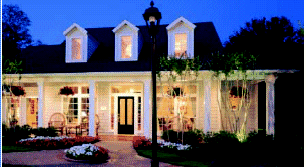

Marketing Manger for
James Hardie Building
Products in America,
John Dybsky (centre)
accepted the 2004
American Building
Award presented by
HOME Magazine during a
ceremony at the 2004
International Builders
Show held in Las Vegas

HOME Magazine has
selected Harditrim®
exterior trim board
with XLD™
Technology as a
winner of a 2004
American Building
Product Award.
HOME Magazine brings
renovating and
decorating ideas and
products to 4,718,000
readers who use the
magazine to investigate
prices and make
purchasing decisions.
Harditrim® exterior
trim board with
XLD™ Technology
uses James Hardie’s
proprietary
manufacturing process
to produce the first
one-inch thick fibre
cement trim board for
windows, corners,
columns and fascia.
While the product is
thicker than the
industry’s standard
3/4-inch thick trim,
its manufacturing
technology makes the
product lightweight, as
easy to cut and nail as
wood, and ensures it
maintains the same
rot-resistance and
low-maintenance
benefits of other James
Hardie fibre cement
products.
Homeowners particularly
appreciate the distinct
shadow lines created by
the product. Like other
James Hardie siding
products, Harditrim®
planks have the look
and character of
natural wood, combined
with the dimensional
stability that allows
them to hold paint for
up to 15 years — three
to four paint-times
longer than wood-based
products.
Harditrim® planks are
available in a 10-foot
length and a variety of
widths including 4, 6,
8 and 12 inches. All
products have a smooth
finish and are backed
by a 10-year limited,
transferable
product-only warranty.
For added protection,
all Harditrim®
products are shipped
with Prime Plus, a
factory-applied priming
system developed
exclusively for James
Hardie siding products
to ensure a superior
surface for topcoat
application.

HardieNews is published by James Hardie Industries NV (ARBN 097 829 895)
incorporated in The Netherlands. The liability of its members is limited. Level
3, 22 Pitt Street, Sydney. GPO Box 3935, Sydney 2001. www.jameshardie.com
Editor: Shane Grimes Tel: +61 2 8274 5225 Fax: +61 2 8274 5218 email:
[email protected]
TM and ® denote a trademark owned by or licenced to James Hardie company or
James Hardie Research Pty Ltd (ABN 31 066 114 092). This document contains
forward looking statements. Forward looking statements are subject to risks and
uncertainties and, as a result, readers should not place undue reliance on such
statements. The inclusion of these forward looking statements should not be
regarded as a representation that the objectives or plans described will be
realised.
Copyright April 2004 James Hardie Australia Pty Ltd ABN 12 084 635 558
























